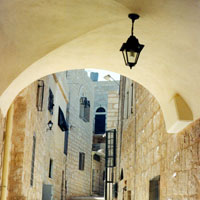Bethlehem’s Quarters
 If the houses themselves only go back several hundred years, some of the stones date back further, as stone was often recycled. The style of house goes back even further—some would say to the Roman or Byzantine Period. That is why local Palestinians have no trouble imagining the Christmas story.
If the houses themselves only go back several hundred years, some of the stones date back further, as stone was often recycled. The style of house goes back even further—some would say to the Roman or Byzantine Period. That is why local Palestinians have no trouble imagining the Christmas story.
Palestinians were well used to their home-grown brand of civil society, democracy, and self-rule Just as the house developed organically, so did the hara or quarter. New families could build inside the hara or against the wall of one of the existing houses. So not everyone was related by blood but they still formed one social unit against outsiders. Until the beginning of the nineteenth century this was perfectly suitable for the small farming town that was Bethlehem, whose fields lapped right at the edges of the houses. But by the middle of the nineteen-century things were beginning to happen which would change these patterns.
As for the original quarters, they are now home to 5,000 souls, for the most part occupied by poor families from other areas. Bethlehem consists of seven quarters that come together like a mosaic to form the core around Manger Square The existing harat of Bethlehem include the Christian Quarters of Harat Al-Najajreh, Harat Al-Farahiyeh, Harat Al-Anatreh, Harat Al-Tarajmeh, Harat Al-Qawawse and Harat Hreizat. The probable date and circumstances under which Harat Al-Fawaghreh, the only Muslim Quarter were formed has recently undergone some research. In addition, there is the Syrian quarter, whose inhabitants, though of relatively recent presence, have contributed much spice to life in Bethlehem. Whatever the quarter, the families are embedded into its physical features and give their names to some of the streets, hoshes, stairs and arches.
"THE TANGIBLE AND INTANGIBLE HERITAGE THAT EXISTS FROM PREVIOUS GENERATIONS PROVIDES A LINK BETWEEN PEOPLE AND THEIR PAST"
- Home/
- Inventory Of Sites
- /Bethlehem’s Quarters



 O-Sense
O-Sense
